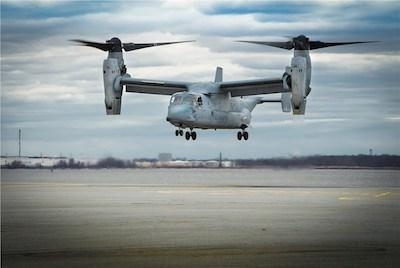Marine Corps Col. Mark Kelly Provided Update At Sea Air Space Exposition
In recent years, the Air Force V-22 variant has been the backbone of the combatant commanders’ ongoing mission to defeat ISIS in Iraq and Syria, according to Marine Corps Col. Matt Kelly.

“As we know, over the last two years, ISIS has lost about 95 percent of their territory, and the CV-22 has been a big part of that mission,” said Kelly (pictured), program manager for the V-22 Joint Program Office, who offered an extensive update on the tiltrotor platform on the second day of the 2018 Sea Air Space Exposition, April 10.
During his talk, Kelly noted V-22’s other recent successes, such as its support last year of humanitarian operations in the aftermath of hurricanes Harvey and Irma, and he repeatedly referred to the platform as a “game-changer,” while describing the current procurement status, readiness initiatives and emerging capabilities. “It’s the most in-demand aircraft in the Department of Defense,” he said. “Every combatant commander wants V-22s … because it can respond to such a wide range of crises and contingencies.”
Today the Program of Record (POR) accounts for more than 450 aircraft, divided between the Marine Corps, Air Force, Navy and Japan (as the program’s first foreign military sales customer), with the Marine Corps accounting for the largest number of those aircraft at 360.
Kelly touted the capabilities of the platform: its max speed, range and ceiling (280 knots an hour, 420 nautical miles and 25,000 feet, respectively). As a tiltrotor aircraft, the V-22 has the versatility of a helicopter and the speed and range of a turboprop. “[The V-22] looks more like a C-130 from a flight envelope perspective than it does an H-60,” he said, adding that it provides a range and lift that no other platform provides.
Breaking down the program’s multiyear procurement, Kelly said Multi-year I has reached completion, while Multi-year II deliveries are on track. He anticipates deliveries for Multi-year II continuing for the next year and a half. Multi-year III, which includes aircraft for the Navy, Marine Corps and Air Force (as well as aircraft for Japan), is currently in negotiation. Under Multiyear III, fiscal 2018 would mark the first year for CMV-22 procurement for the Navy, with those aircraft being delivered in fiscal 2020. “We feel we will have that contract signed in June of this year,” Kelly said. “So that will span five additional years, fiscal 2018 through fiscal 2022.”

Kelly also described the potential of the multi-year’s additional capacity. “[Negotiating] the contract, we knew that other U.S. services and other foreign partners would probably want to get in on this, too, since we’re getting a great deal pre-negotiating prices.”
Pre-negotiated prices should ensure that, for the next few years, U.S. services and foreign military sales customers wishing to acquire the aircraft will know exactly how much it will cost them—with “no guesswork involved.”
On the topic of readiness, Kelly directed the audience’s attention to the Marine Corps’ current initiative: Common Configuration – Readiness and Modernization (CC-RAM), which updates MV-22s that are 10 to 12 years old to 2018 standards. Kelly believes the program will pay big dividends. “It takes all the engineering changes that we made over the last 15 years that have to do with readiness … and [incorporates] them into the aircraft,” he said.
While CC-RAM is meant to improve the reliability of the current MV-22 aircraft, it’s also meant to ensure the aircraft’s engineering—the wiring, the avionics, the structure—are common across the fleet. “[We found] there were over 70 configurations of MV-22s in the fleet. That was crushing the fleet from a maintenance and supportability standpoint,” Kelly said.
The vision of CC-RAM is that all MV-22s will one day have the same maintenance publications, the same procedures, the same supply chain and the same support equipment—so that Marines can support the aircraft more easily and efficiently than they can today. “They won’t have to worry about what aircraft [they’re] going to [or] what variant of the maintenance manual … they need for that particular aircraft,” Kelly explained.
With the CMV-22 forecast for delivery to the Navy in 2020, the V-22 program office has been working with the Navy for more than two years to determine its optimal requirements. “Basically what it comes down to is about 5,500 pounds of extra fuel to support the greater range and payload—in addition to some communications gear and a public address system for the interior of the aircraft,” Kelly said.
In August 2016, the Marine Corps collaborated with the Navy on the “Fleet Battle Experiment,” during which MV-22s assigned to Marine Operational Test and Evaluation Squadron (VMX)1 landed aboard USS Carl Vinson (CV 70) to explore the platform’s operational potential within a carrier strike group. The experiment lasted about three weeks. “In that period, the Navy was able to begin developing some of the tactics, techniques and procedures … and take advantage of some of the great things that [the Navy’s] current [carrier onboard delivery] COD platform cannot,” Kelly said.
Key among those emerging capabilities is the V-22’s ability to deliver the F-35 power module, which weighs several thousand pounds, to the carrier in support of the F-35B/C Lightning II. Among the platform’s other emerging capabilities is the V-22 Aerial Refueling System (VARS), a roll-on tanker kit for the V-22 that would support Marine Expeditionary Units. The system, which turns the V-22 into an aerial tanker, has so far undergone a concept demonstration. “Flight tests in earnest will start later this year, in the fall,” Kelly said. “We know that this capability is going to be a real force-multiplier.”
As the mainstay of the Marine Corps’ amphibious force, the V-22 must have the same level of digital interoperability that every platform today is pursuing, Kelly said, noting that the capability had become something like an unofficial theme of the exposition. “I’m sure every briefing you’ve gone to [presenters] will talk about the importance of being connected and networked as a platform,” he said.
The warfighter of today, he noted, requires ever-increasing digital interoperability between ground forces, air forces and sea forces that ensure all share a common operating view of the battlespace.
According to Kelly, the program office’s initial step will be developing a response to an Urgent Universal Needs Statement that will go out to the fleet later next year. “Digital interoperability is a key capability that’s going to enable the Marine Corps and the V-22 to stay relevant and effective for the next 20 to 30 years,” he said.
(Source: NAVAIR news release. Images from file)
 ANN's Daily Aero-Term (04.20.24): Light Gun
ANN's Daily Aero-Term (04.20.24): Light Gun Aero-News: Quote of the Day (04.20.24)
Aero-News: Quote of the Day (04.20.24) ANN's Daily Aero-Linx (04.21.24)
ANN's Daily Aero-Linx (04.21.24) Aero-News: Quote of the Day (04.21.24)
Aero-News: Quote of the Day (04.21.24) ANN's Daily Aero-Term (04.21.24): Aircraft Conflict
ANN's Daily Aero-Term (04.21.24): Aircraft Conflict




